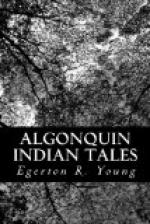The mother noted the unusual expectancy manifested by the children during the day, and on inquiring the reason was promptly informed that Mary had promised to tell them a story, or legend, and “had got to do it.”
“Why has she got to do it?” said the loving mother, struck with the emphasis which they had placed on the word.
The little mischiefs were cunning enough to see that they had nearly run themselves into trouble, and were wisely silent. Mary also noticed this, and at once her great loyalty to the little folk manifested itself, and quickly turning to her mistress she said, with an emphasis which was quite unusual:
“Mary has promised them a story, and as she always keeps her word she has got to tell it.”
Saying this she quickly sprang from the floor, where she had been sitting, and taking a child by each hand she marched with them out of the room.
“Hurrah for you, Mary! you saved us that time,” said little Sagastao.
Mary would not have been sorry if in some way the parents received an inkling of what was in the minds of the children, yet she had such peculiar ideas that she would never herself be the one to convey that information.
During the brief summer months the pleasantest walks were along the shores of the lake. Many were the cosy little cave-like retreats where Mary often led the children. There, with the sunlit waters before them, and the rippling waves making music at their feet, the old nurse crooned out many an Indian legend or exciting story about the red men of the past. To-day, however, she was perplexed by the attitude of the children and could not select any story that she thought of sufficient interest to divert their minds from Souwanas and Nanahboozhoo. So for a time they wandered on along the pleasant shore, or turned aside to gather the brilliant wild flowers.
A scream of pain from Minnehaha interrupted their pleasure. In gathering some wild lilies she was stung on both hands by some honey bees that were in the flowers. Mary quickly made a batter of clay and bound up the wounded hands in it. Then she sat down and took the child in her lap.
“Naughty bees to sting me like this,” said Minnehaha, with tears streaming down her cheeks. “I was not doing them any harm.”
“Yes, you were, and so were we all,” said the brother. “We were carrying off the flowers from which they get their honey, which is their food.”
“Well, they might let us have a few flowers without stinging us,” replied Minnehaha.
The intense pain of the stings rapidly abated under Mary’s homely but skillful treatment, and as the child still retained her place in Mary’s lap she said,
“Can you tell us why such pretty little things as bees have such terrible stings? My hands felt as if they were on fire when I was first stung, and I could not help crying out with the pain.”
“Well,” said Mary, “there was a time when the bees had no stings, and they were as harmless as the house flies. They were just as industrious as they are now, but they had any amount of trouble in keeping their honey from being stolen from them, for every creature loves it.




